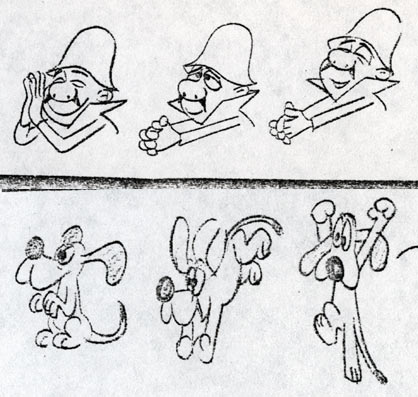

A Tale of Old Whiff

(click on the image above to see more of this model sheet)
With so much attention being paid nowadays to film gimmickry like stereoscopic 3D, it may be only a matter of time before Hollywood begins resurrecting other outlandish ideas from the past, like Smell-O-Vision. As far as I’m aware, there’s only one piece of animation ever produced using the Smell-O-Vision process, in which audiences were exposed to aromas that accompanied the visuals onscreen. The cartoon is called A Tale of Old Whiff. I’ve never seen the short, but I can offer the model sheet above which allows us to see what the characters looked like.
A reviewer named F. Gwynplaine MacIntyre has written extensive commentary about the short on IMDB that includes the following synopsis:
Bert Lahr does hilarious work as the voice of Old Whiff, a cartoon bloodhound searching for a museum’s lost dinosaur bone worth $100,000 … but whose search is hampered by the fact that he has lost his sense of smell. While the bloodhound meanders through this cartoon, muttering to himself in Bert Lahr’s distinctive voice, we see various items which Old Whiff encounters … including a hot dog, mustard, soap, soup, chocolate, violets, pine trees, a field of clover and a horse. We also SMELL those objects; at least we smell them if the Smell-O-Vision process is working properly. But poor Old Whiff can’t smell anything.
I found the faded and many-times photocopied model sheet in the collection of Alan Zaslove, who is credited with directing the film. The film was originally being directed by John Hubley in New York but, for reasons that are unclear, he abandoned the project midway. The most likely scenario is that he had a financial or creative conflict with the bankroller of the Smell-O-Vision process, the notorious Hollywood producer Mike Todd.
Zaslove remembers that all of the artwork, including much of the completed animation, was shipped by Hubley to to Format Films in LA, where it was photographed and completed. Story artist Leo Salkin, who was working at Format at the time, is credited with storywork on the film, which perhaps implies that the story of the film wasn’t completely figured out when Hubley stopped working on the film. I’m not sure if the model sheet above was drawn entirely by Hubley, but the designs are certainly his, and a lot of the drawings look like they could be from his hand.

.png)